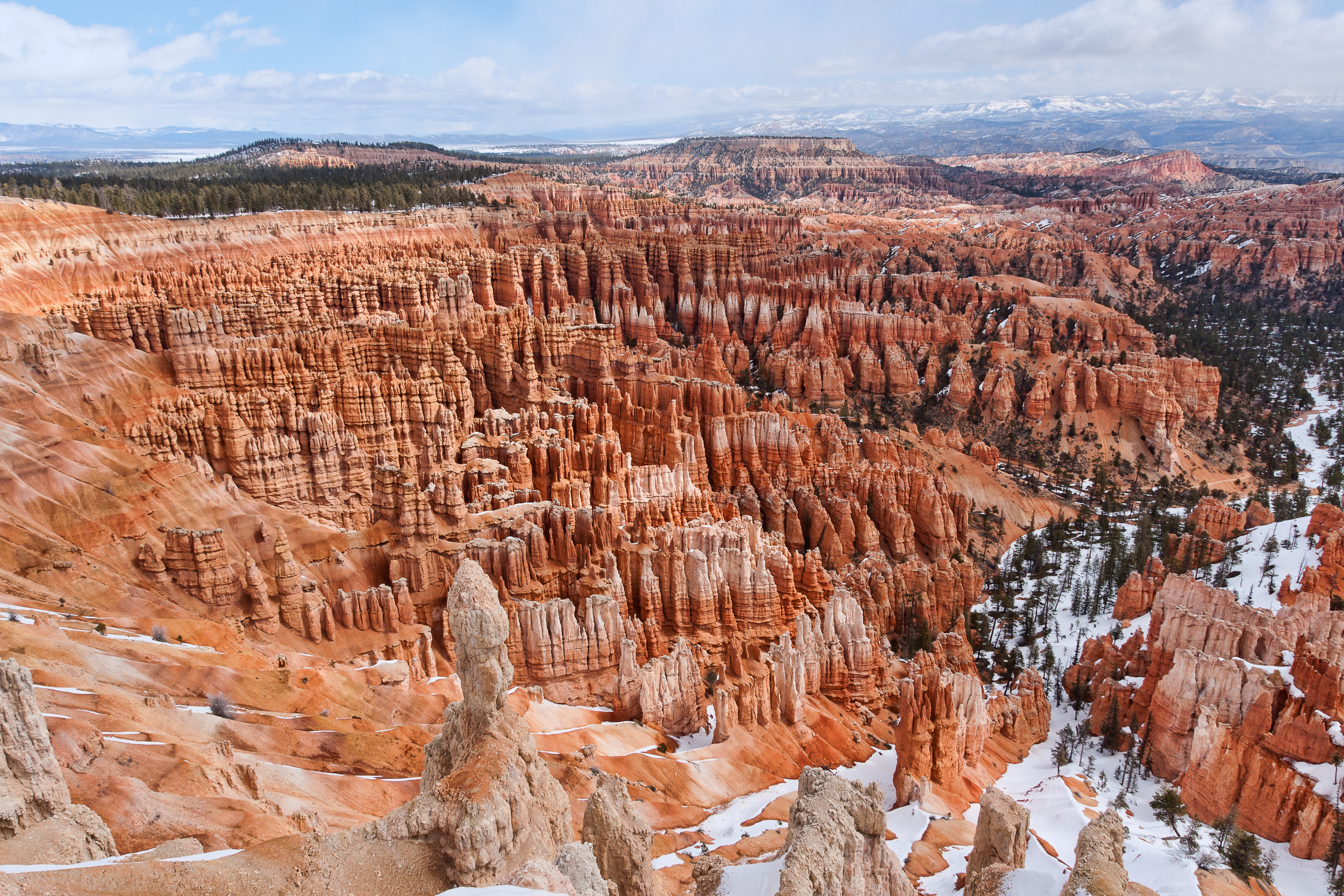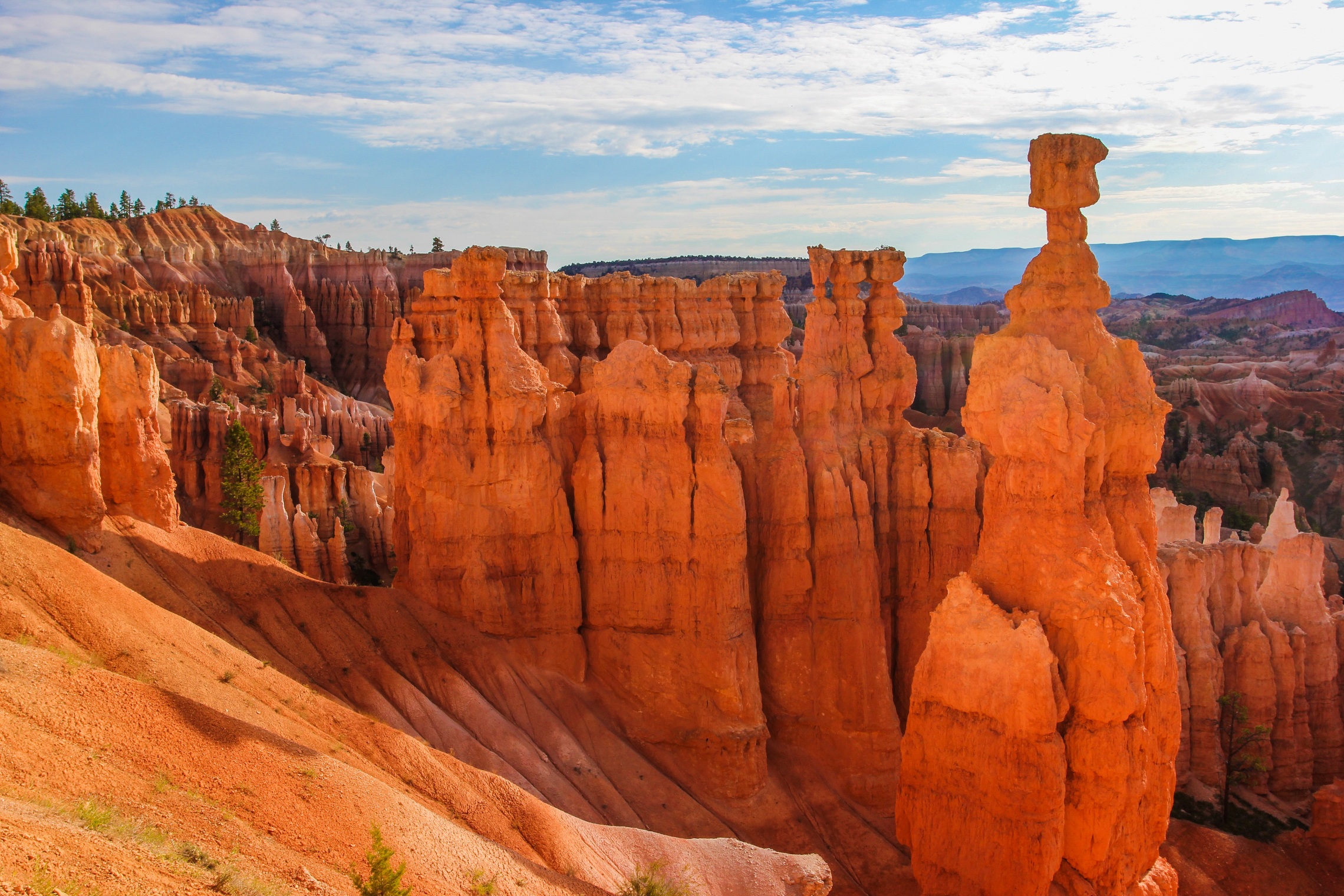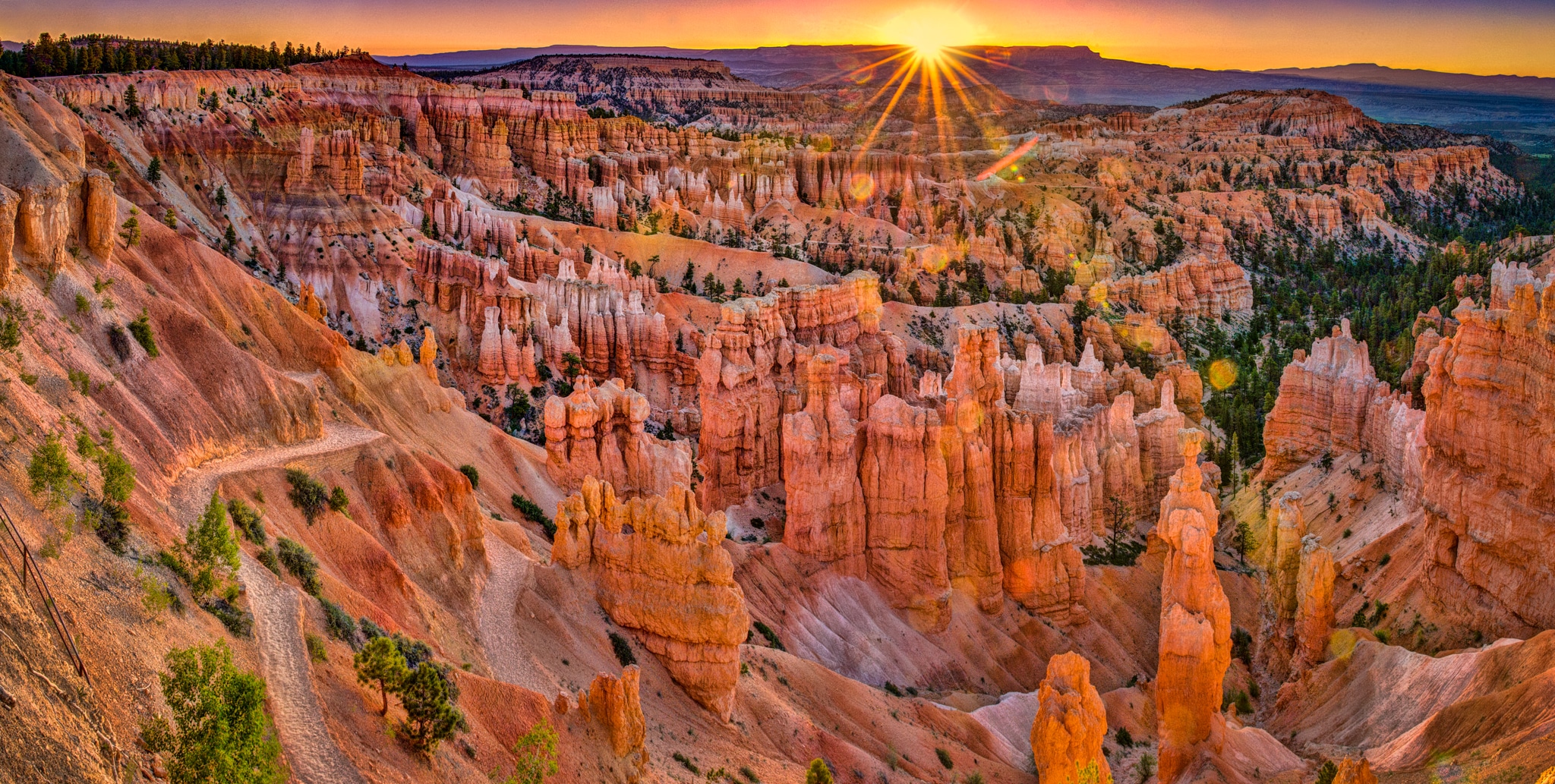Bryce Canyon - Utah's Unique Rock Formations
When you think about places that truly capture your attention, Bryce Canyon in southwestern Utah kind of stands out. It’s a spot where the land shows off some really striking reddish stone formations, soft, almost rosy-colored rock faces, and vast stretches of scenery that just seem to go on forever. And those hoodoos, you know, those tall, irregular columns of rock, they pop up in various places all around the globe. But what's truly remarkable about this particular location is that it holds the largest collection of these unusual rock pillars anywhere on our whole planet, actually.
This amazing area is formally known as Bryce Canyon National Park, and while it carries the name "canyon," it's not really a canyon in the way you might picture one, like a deep, narrow cut in the earth. Instead, it presents itself more like a series of natural amphitheaters, scooped out of the high plateau, which is quite a different sort of geological wonder, to be honest.
Even though Bryce Canyon is considered the smallest national park in Utah, don't let its size fool you. There's an incredible amount to experience and see here, so you really won't feel like you're missing out on anything. It’s a place that invites you to explore, to simply take in the views, and to truly connect with the natural world around you, as a matter of fact.
Table of Contents
- What Makes Bryce Canyon So Special?
- Exploring the Views at Bryce Canyon
- Is Bryce Canyon a True Canyon?
- What Can You Do in Bryce Canyon?
- How Does Nature Shape Bryce Canyon?
- Planning Your Visit to Bryce Canyon
- Life Around Bryce Canyon
What Makes Bryce Canyon So Special?
You know, there are plenty of spots on our planet where the land does some pretty interesting things, but Bryce Canyon has this way of just grabbing your attention. It's got a certain something that makes it truly stand apart. The sheer amount of those distinctive rock formations, the hoodoos, is really what makes this place quite unlike any other. They stand there, these tall, sometimes spindly, sometimes stout, pillars of stone, all in different shades of red, orange, and cream, creating a scene that feels almost out of a storybook, as a matter of fact.
The way the sunlight hits these formations throughout the day, especially when the sun is just coming up or starting to go down, is really something else. The colors seem to shift and change, making the rocks appear to glow with an inner light. It’s a very dynamic sort of beauty, where what you see one moment might look a little different the next, depending on the angle of the light. This constant play of shadow and illumination just adds to the overall wonder of the place, you know.
It’s also the feeling of being there, surrounded by so much natural artistry, that contributes to its specialness. You feel small, in a good way, like you’re a part of something much bigger and older than yourself. The air can be crisp, especially at higher elevations, and the quiet can be quite profound, allowing you to really soak in the sights and sounds, or lack thereof, of this extraordinary outdoor space, too it's almost.
The Hoodoos of Bryce Canyon
So, these hoodoos are really the main act here at Bryce Canyon. They are, basically, irregular columns of rock, often with a sort of caprock on top that helps protect the softer rock underneath from wearing away as quickly. This is how they get their often whimsical and sometimes rather peculiar shapes. Think of them as natural sculptures, each one a unique piece carved by the patient hand of the weather over many, many years, you know.
While you can find these sorts of rock formations in various parts of the world, what makes Bryce Canyon truly exceptional is the sheer number of them all gathered together in one spot. It’s like a massive natural gallery, filled with thousands upon thousands of these stone figures. They stand shoulder to shoulder, stretching out across the landscape, creating a sight that is pretty much unparalleled anywhere else on Earth, actually.
Some of these hoodoos have even been given names by people who visit, because their shapes can sometimes suggest familiar objects or figures. You might see one that looks like a person, or another that resembles an animal, or perhaps a castle turret. This just adds another layer of fun to exploring the park, as you try to spot these "characters" among the countless rock formations, which is kind of neat, you know.
Exploring the Views at Bryce Canyon
When you come to Bryce Canyon, a lot of the magic happens just by looking out from the various viewpoints. The park is set up in a way that makes it easy to take in the vastness of the place from many different angles. You can simply stand at an overlook and let your eyes wander over the expansive natural amphitheaters, taking in the grand scale of the rock formations and the way they stretch out into the distance. It’s a very visual experience, naturally.
Each overlook seems to offer a slightly different perspective, showing you new arrangements of the hoodoos and fresh ways that the light plays on the rock faces. Some spots give you a wide-open panorama, while others might focus your gaze on a particular cluster of formations, allowing you to appreciate the smaller details. It’s really about taking your time and letting the scenery wash over you, just a little.
The air at Bryce Canyon is often clear, and on a good day, you can see for miles and miles, which adds to the feeling of immense space. The views are not just about the rock formations themselves, but also about the vast skies above and the distant horizons, which can be quite a sight, especially at sunrise or sunset, of course.
Walking the Rim at Bryce Canyon
One of the most popular ways to really experience the views at Bryce Canyon is by taking a stroll along the rim trail. This pathway runs along the edge of the main amphitheater, offering continuous, breathtaking sights of the hoodoos below. It’s a pretty accessible way to see a lot of the park’s main features without having to venture too far down into the formations themselves, you know.
As you walk along this path, you’ll come across numerous designated overlooks, each providing a unique vantage point. Some of the most well-known spots include Inspiration Point, which is often a traveler's favorite, giving you a truly sweeping look at the grand scale of the place. There’s also the main Rim Trail itself, which is very popular for a reason, offering consistent and stunning visual experiences, basically.
The beauty of walking the rim at Bryce Canyon is that you can choose how much of it you want to do. You can take a short walk between a couple of overlooks, or if you’re feeling up to it, you can cover a longer distance, experiencing how the scenery changes as you move along the edge. It’s a flexible way to enjoy the park’s visual splendor, allowing you to go at your own pace, which is quite nice, really.
Is Bryce Canyon a True Canyon?
This is a question that often comes up, and it’s a good one, because despite its name, Bryce Canyon isn't actually a canyon in the typical way we think of one. When most people hear "canyon," they picture a deep, narrow cut in the earth, usually carved out by a river over a very long time, like the Grand Canyon, for example.
However, Bryce Canyon is quite different. It wasn't formed by a single river cutting through rock. Instead, it’s more of a series of natural amphitheaters, or giant bowl-shaped depressions, that have been scooped out of the eastern edge of a high plateau. The forces that shaped it were primarily frost wedging and the slow wear and tear of rain and ice, which is a bit different from typical river erosion, you know.
So, while it has deep walls and impressive formations, it lacks the single, continuous river channel that defines a traditional canyon. This distinction is actually pretty important because it helps you appreciate the unique geological processes that created this specific kind of landscape, making it a very special place in its own right, as a matter of fact.
The Amphitheater Shape of Bryce Canyon
The most striking feature of Bryce Canyon is definitely its amphitheater shape. Imagine a series of enormous natural bowls, each one filled with thousands of those distinct hoodoo formations. These amphitheaters are not just one big, continuous feature, but rather several distinct ones, each with its own character and arrangement of rock pillars, you know.
The main amphitheater is the largest and most well-known, and it's where many of the park’s most famous viewpoints are located. From these vantage points, you can look down into these vast, open spaces, seeing the hoodoos spread out below you like an army of stone figures. The scale of it is pretty remarkable, and it truly gives you a sense of the sheer volume of these formations, as a matter of fact.
The way these amphitheaters are formed, with their scalloped edges and deep depressions, allows for a truly immersive visual experience. You're not just looking at a flat expanse; you're looking down into a complex, three-dimensional world of rock, where shadows and light play tricks on your eyes, and every turn offers a slightly new perspective on the intricate shapes of Bryce Canyon, you know.
What Can You Do in Bryce Canyon?
Despite Bryce Canyon being known as the smallest national park in Utah, there's honestly a lot more to do here than you might initially think. It’s not just about standing at an overlook and taking a few pictures, though that's certainly a big part of the experience. The park offers a variety of ways to get closer to its unique geological features and to simply enjoy being out in nature, actually.
You can spend a good amount of time simply walking along the various paths that wind through the park. Many visitors really enjoy taking a stroll on the rim trail, as we talked about, which offers those amazing views from above. But if you're feeling a bit more adventurous, there are also trails that lead down into the amphitheaters, allowing you to walk among the hoodoos themselves, which is a pretty cool experience.
Beyond just walking, there are opportunities for longer hikes, and for those who enjoy spending a night under the stars, camping is an option within the park. It’s a place that caters to different levels of activity, so whether you prefer a leisurely pace or something more physically engaging, you'll likely find something that suits your preferences here, as a matter of fact.
Beyond the Overlooks in Bryce Canyon
While gazing across the amphitheater from numerous overlooks is a definite highlight, Bryce Canyon truly invites you to go a little deeper. You can descend into the formations on trails like the Queen's Garden or Navajo Loop, which allow you to walk right among the hoodoos. It’s a completely different feeling to be surrounded by these towering rock pillars, looking up at them instead of down, you know.
For those who want to see more, there's a pretty good list of activities. Travelers often speak highly of Inspiration Point, which is often ranked as a top spot, offering truly expansive views. The Rim Trail, too, is a very popular choice for a reason, providing continuous access to incredible scenery. There are, in fact, many more things to do beyond just these two, like exploring different hiking paths or even looking into ranger programs, for instance.
The park’s official travel guide is a really helpful resource for figuring out all the possibilities. It gives you details on visitor center hours, any fees you might need to know about, and information on hiking trails, camping spots, and other practical tips to help you plan your visit to Bryce Canyon. It’s definitely worth checking out before you arrive, to be honest.
How Does Nature Shape Bryce Canyon?
It’s kind of incredible to think about how the landscape at Bryce Canyon came to be. Perhaps nowhere else can you feel the forces of natural erosion quite so strongly. You can literally see the evidence of how wind, water, and ice have worked together over millions of years to sculpt these incredible rock formations. It’s a very active process, even though it happens so slowly that we don’t notice it from day to day, you know.
The primary way Bryce Canyon gets its unique look is through something called "frost wedging." Basically, water seeps into cracks in the rock. When temperatures drop below freezing, that water turns into ice, and ice expands. This expansion puts pressure on the rock, making the cracks wider. Over time, this repeated freezing and thawing slowly breaks off pieces of rock, gradually shaping the hoodoos and the amphitheaters, which is pretty fascinating, actually.
Rainfall also plays a part, washing away loose bits of rock and carving channels. The combination of these natural elements working together has resulted in the truly dazzling display of nature's artistry that you see today. It’s a constant, slow dance between the land and the elements, always changing the face of Bryce Canyon, in a way.
The Sculpting Forces Behind Bryce Canyon
The creation of Bryce Canyon, a truly captivating gem in southwestern Utah, is a wonderful example of how the Earth’s natural processes can create something so visually striking. It unfolds in what feels like a dazzling display of nature's artistry, all thanks to the patient, persistent work of the weather. These aren't sudden changes, but rather the result of countless cycles of freezing and thawing, along with the gentle washing action of rain, you know.
The softer layers of rock wear away more quickly, leaving behind the harder, more resistant layers, which often form the caps or the more prominent parts of the hoodoos. This differential erosion is what gives each hoodoo its distinct and often whimsical shape. It’s like nature is a sculptor, slowly chipping away at a block of stone, revealing the intricate forms hidden within, as a matter of fact.
You can see these forces at work everywhere you look in Bryce Canyon. The way the rock faces are grooved, the way individual hoodoos stand tall while others are shorter, it all tells a story of constant, slow change. It’s a living geological exhibit, always being reshaped, always presenting new aspects of its unique beauty, which is quite something to behold, honestly.
Planning Your Visit to Bryce Canyon
If you're thinking about coming to Bryce Canyon National Park, which is a part of the national treasure that is the Grand Circle, you'll be joining thousands of visitors each year who come to explore this geological marvel. It’s a place that really draws people in, and a little bit of planning can make your experience even better, naturally.
To help you get ready, there’s an official travel guide available that covers all sorts of useful information. This guide can tell you about things like visitor center hours, any fees you might need to pay to get into the park, and details on hiking trails and camping options. It’s designed to give you all the helpful information you might need

Bryce Canyon National Park - Wikiwand

Bryce Canyon National Park, Southwest Utah, USA - Traveldigg.com

Bryce Canyon National Park Sunrise Viewpoints: Captivating Beauty and